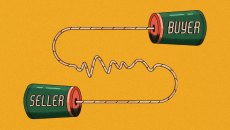How ad tech’s measurement titans are pivoting to attention and activation

It’s earnings season, hence a slew of compulsory report cards released by publicly traded companies with disclosures that are typically interpreted as a barometer of challenges (and opportunities) for the wider market.
Last week saw two of the more notable companies from the post-pandemic ad tech gold rush (the titans of the online ad measurement sector: DoubleVerify and Integral Ad Science) make their disclosures with announcements some deem emblematic of wider market trends.
These are shifting sands everyone must make adjustments for, with one widely held interpretation is that both DoubleVerify and IAS believe that next year will see the final demise of third-party cookies.
Simply put, there’ll be no more respite for the ‘common currency’ of ad tech, even if some of the largest independent ad tech vendors aren’t necessarily sold on the data, and this duo is starting to evolve – in their respective ways.
Firstly, an initial look at their most recent quarterly earnings (see below), results that meant DoubleVerify’s market capitalization was in the region of $5.5 billion almost a week after it announced its Q2 earnings for 2023, while IAS’ was just below $2.3 billion for the same period.
- DoubleVerify’s Q2 revenue was $133.7 million, up 22% year on year, full-year guidance was $557 million-to-$569 million, EBITDA in the range of $171 to $179 million
- IAS’ Q2 revenue was 113.7 million, up 13% year on year, full-year guidance was $459 million-to-$465 million, EBITDA of $149 million to $153 million
Ad position: web_incontent_pos1
On the companies’ subsequent earnings calls, it would appear that both are transitioning from their genesis as verification providers towards media activation as the rock-solid data signals of third-party cookies and IDs such as IDFA become more scant.
According to its disclosure, media activation generated $77.9 million of DoubleVerify’s Q2 revenue, an annual increase of 29% – this is more than 55% of its advertisers-generated revenue claims the company. Evidence of DoubleVerify doubling down on activation was further crystalized by its Q2 disclosure also containing details of its intention to purchase Scibids for $125 million.
“We expect this strategic investment to transform our long-term growth trajectory by making our sizable and successful Activation business more impactful and enhancing our measurement data all while accelerating DV’s evolution from protection to performance,” said DoubleVerify CEO Mark Zagorski in a press statement.
For some, the purchase of an AI-specialist like Scibids would point to DoubleVerify using a probablistic approach to helping advertisers gauge the context of their media placements. “We look at attention as being the cross-section of exposure [gleaned from its viewability data] and engagement,” Zagorski explained to Digiday, adding, “It looks at how long an ad runs on page, where it fits and whether it’s been seen by a real human.”
Ad position: web_incontent_pos2
Representatives of IAS did not respond to Digiday’s request for comment on how it produces its attention metrics by press time but on its Q2 earnings report, the company discussed its tie-up with Lumen Research suggesting it is adopting a deterministic approach.
“In June, we launched our Quality Attention post-bid measurement product. Quality Attention is focused on driving quality impressions, boosting higher engagement rates without scale issues and driving higher conversion,” reads a prepared statement from IAS CEO Lisa Utzschneider.
Although, when considering the ‘probabilistic vs. deterministic’ debate, it is worth noting that DoubleVerify has partnered with TVision to gather “eyes-on-screen attention data” to help fuel its growing CTV attention offering in the market.
Speaking with Digiday after both companies issued their Q2 results, Lumen Research CEO Mike Follett described how both approaches were not trying to replace the cookie, rather his outfit’s partnership with IAS was indicative of its attempting to find an alternative to the cookie. “It’s like cookies are dinosaurs, and attention data is a mammal,” he added.
Although, with both companies increasingly moving into media activation – remember how IAS purchased TV ad serving company Publica – is this too much of a departure from their respective roots as measurement companies in the days when deterministic data was more easy to come by?
In other words, how can companies be considered an honest broker when informing a media bid, and the referee who makes the call as to whether or not it performed well?
“I feel it opens them up to a potential conflict,” said Ruben Schreurs, chief strategy officer at Ebiquity, adding, “It all depends on the commercial model, and incentive … if there is a fee-based model on the volume of impressions bought using the Scibids model [that] creates an incentive to maximize the impressions won.”
DoubleVerify’s Zargorski emphasized that his company’s media activation offering meant that advertisers are in control. “DV doesn’t make any decisions, we’re giving them the fishing rod and the bait, they have to go fish,” he added.
Answering requests for clarity on the revenue models, therefore incentives to rate media, he added his prebid solutions work on a cost-per-impression basis while Scibids works on a percentage of media model. Although, the latter may change as it looks to integrate Scibids into the DoubleVerify umbrella.
“We’re looking at how that model is going to change [pending the completion of the Scibids acquisition], as obviously they are two different models,” added Zagorski. “In future we’ll find what’s best for advertisers.”
More in Media

NewFronts Briefing: Samsung, Condé Nast, Roku focus presentations on new ad formats and category-specific inventory
Day two of IAB’s NewFronts featured presentations from Samsung, Condé Nast and Roku, highlighting new partnerships, ad formats and inventory, as well as new AI capabilities.

The Athletic to raise ad prices as it paces to hit 3 million newsletter subscribers
The New York Times’ sports site The Athletic is about to hit 3 million total newsletter subscribers. It plans to raise ad prices as as a result of this nearly 20% year over year increase.

NewFronts Briefing: Google, Vizio and news publishers pitch marketers with new ad offerings and range of content categories
Day one of the 2024 IAB NewFronts featured presentations from Google and Vizio, as well as a spotlight on news publishers.
Ad position: web_bfu




